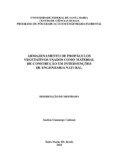| dc.creator | Cadoná, Suelen Camargo | |
| dc.date.accessioned | 2021-07-08T20:50:14Z | |
| dc.date.available | 2021-07-08T20:50:14Z | |
| dc.date.issued | 2014-02-28 | |
| dc.identifier.uri | http://repositorio.ufsm.br/handle/1/21357 | |
| dc.description.abstract | Soil bioengineering is a discipline of civil engineering that uses live elements as construction materials in order
to produce technical effects, without neglecting aesthetic and ecological issues. Plant propagules are one of the
most employed vegetative materials in different soil bioengineering schemes. These propagules are used to
stabilize soil engineering properties by means of the posterior plant root development. Live material, consisting,
in general, of wooden stakes and stem posts, could not be stored indefinitely, having a maximum or an optimal
storage period before being implanted as construction material in soil bioengineering interventions. The
objective of this work is to evaluate the most appropriate storage to preserve plant propagules (wooden cuttings)
viability. Three species had been used for the study: Phyllanthus sellowianus, Salix humboldtiana and
Sebastiania schottiana. Propagules of those three species are stored in three different wrap materials: Kraft
paper, moist transparent polyethylene and dry transparent polyethylene. Each packed set is then preserved in two
different temperature states (room temperature – unrefrigerated – and refrigerated environment at 8°C ± 2ºC).
The vegetative viability of the material is verified by means of the success rate (IP) of the implanted sets,
evaluated after different storage periods: reference sampling (non-stored), 3, 6, 9, 12, and 15 days. The live
cuttings had their IP evaluated after 60 days of planting. The results show that the dry polyethylene storage
produced the best preserving effects. Storage in Kraft paper, allowed moisture exchange between plant material
and external environment. This fact leads to fast dehydration and death of the plant material. Moist polyethylene
packing, meanwhile, creates conditions for the proliferation of fungi and bacteria, also reducing the vitality of
the stored material. The results indicate that the storage of the studied species is feasible in dry polyethylene
packing for up to 15 days (maximum tested period). The main refrigeration effects are: to decrease fungi and
bacteria proliferation and to improve S. humboldtiana viability. S. schottiana success rate is significantly
improved when it is stored by at least three days before planting The obtained results are useful as important
information for planning and scheduling soil bioengineering works execution. | eng |
| dc.language | por | por |
| dc.publisher | Universidade Federal de Santa Maria | por |
| dc.rights | Attribution-NonCommercial-NoDerivatives 4.0 International | * |
| dc.rights.uri | http://creativecommons.org/licenses/by-nc-nd/4.0/ | * |
| dc.subject | Propagação vegetativa | por |
| dc.subject | Bioengenharia de solos | por |
| dc.subject | Phyllanthus sellowianus | por |
| dc.subject | Salix humboldtiana | por |
| dc.subject | Sebastiania schottiana | por |
| dc.subject | Vegetative propagation | eng |
| dc.subject | Soil bioengineering | eng |
| dc.title | Armazenamento de propágulos vegetativos usados como material de construção em intervenções de engenharia natural | por |
| dc.title.alternative | Storage of plant propagules used as construction material in soil bioengineering interventions | eng |
| dc.type | Dissertação | por |
| dc.description.resumo | A engenharia natural é uma disciplina da engenharia que utiliza elementos vivos como materiais de construção
capazes de produzirem efeitos técnicos, bem como estéticos e ecológicos. Entre outras formas, propágulos
vegetativos são utilizados em diferentes arranjos técnicos visando melhorar as propriedades de engenharia dos
solos através do desenvolvimento radicular das plantas. Os materiais vivos, sejam estacas lenhosas ou outras
partes da planta, possuem um período ideal ou máximo de estocagem antes de sua utilização em obra. O objetivo
deste trabalho é avaliar formas de armazenamento que melhor preservem a viabilidade de propágulos vegetativos
(estacas lenhosas). Três espécies foram utilizadas para o estudo: Phyllanthus sellowianus, Salix
humboldtiana e Sebastiania schottiana. Propágulos vegetativos (estacas lenhosas) dessas espécies foram
acondicionados para armazenamento em três diferentes formas: papel Kraft, polietileno transparente úmido e
polietileno transparente seco. Esses foram conservados em duas condições de acondicionamento (temperatura
ambiente - sem refrigeração - e ambiente refrigerado com temperatura de 8°C ± 2ºC). A viabilidade do material
foi verificada através do índice de pega (IP) do material plantado, avaliado após diferentes períodos de
armazenamento: testemunha (sem armazenamento), 3, 6, 9, 12, e 15 dias. As estacas tiveram seu IP avaliado
após 60 dias do plantio. Os resultados mostram que o armazenamento em embalagens de polipropileno seco
produz os melhores efeitos de preservação. O acondicionamento em embalagem de papel Kraft, permite a troca
de umidade entre o material vegetal e o ambiente externo, o que leva à rápida desidratação e à morte do material
vegetal. Já a embalagem de polietileno úmida cria condições para a proliferação de fungos e bactérias o que,
igualmente, reduz a vitalidade do material armazenado. Os resultados obtidos mostram que o armazenamento do
material vegetal para as espécies estudadas é viável em embalagem de polietileno seco por até 15 dias (máximo
testado). A refrigeração reduz a proliferação de patógenos e aumenta o IP de S. humboldtiana. Já a espécie S.
schottiana tem seu IP significativamente melhorado quando armazenada por pelo menos três dias antes do
plantio. As informações obtidas são úteis no planejamento do cronograma de execução de obras que utilizem
propágulos lenhosos vivos. | por |
| dc.contributor.advisor1 | Sutili, Fabrício Jaques | |
| dc.contributor.advisor1Lattes | http://lattes.cnpq.br/5871729986469148 | por |
| dc.contributor.referee1 | Gavassoni Neto, Elvidio | |
| dc.contributor.referee2 | Mantovani, Nilton César | |
| dc.creator.Lattes | http://lattes.cnpq.br/2730072405415701 | por |
| dc.publisher.country | Brasil | por |
| dc.publisher.department | Recursos Florestais e Engenharia Florestal | por |
| dc.publisher.initials | UFSM | por |
| dc.publisher.program | Programa de Pós-Graduação em Engenharia Florestal | por |
| dc.subject.cnpq | CNPQ::CIENCIAS AGRARIAS::RECURSOS FLORESTAIS E ENGENHARIA FLORESTAL | por |
| dc.publisher.unidade | Centro de Ciências Rurais | por |



